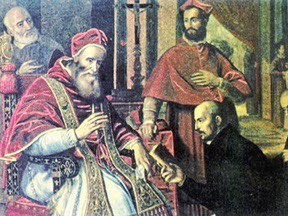St. Ignatius of Loyola (1491-1566) was the founder of the Society of Jesus, also known as the Jesuit Order.He lived in the same era as the great reformer Martin Luther (1483-1546). The Pope gave Loyola and the Jesuits the duty of neutralizing Luther and the Reformation. Read more about the Counter Reformation in Protestantism Destroyed
Submission
Luther’s appeal was that we are to submit directly to God through the Scriptures, "by which our consciences should be formed and confirmed."i
Loyola’s aim was for everyone to submit their consciences to the Papacy. The Jesuit Oath requires that the person follow the Pope perinde ac cadaver; that is, "as a corpse." Submission to the Papacy and the Superior General of the Jesuits is, according to Ignatius, meant to be absolute and removes personal opinions or wills:
"Let us be convinced that all is well and right when the superior commands it," wrote Loyola. And again: "Even if God gave you an animal without sense as a master, you will not hesitate to obey him, as master and guide, because God ordained it to be so."ii
All judgment laid aside, we ought to have our mind ready and prompt to obey, in all, the true Spouse of Christ our Lord, which is our holy Mother the Church Hierarchical.iii
Faith
Loyola taught "Ignatian Spirituality," achieved through spiritual exercises that put imagination and experiential religion in the place of reality and faith. Luther taught that "faith cometh by hearing, and hearing by the word of God" (Romans 10:17), while Loyola popularized a spirituality of the senses, in which feelings and visions are to be trusted.
Luther believed that "by grace ye are saved" (Ephesians 2:4, see also 2:5-8), and, "Then good works are bound to follow, which are the fruits of repentance."iv Loyola and the Jesuits, on the other hand, taught that good works are means for salvation:
...the exterior penances are done chiefly for three ends: First, as satisfaction for the sins committed; Second, to conquer oneself— that is, to make sensuality obey reason and all inferior parts be more subject to the superior; Third, to seek and find some grace or gift which the person wants and desires (emphasis added).v
Guilt and Sin
Whereas Martin Luther wrote that repentance is the first step to salvation, Loyola expressed that guilt should be dealt with by beating the body and seeking supernatural experiences. Luther said this:

Ignatius of Loyola receiving recognition from Pope Paul III on September 27, 1540, for his Society of Jesus.
The true way to Christianity is this, that a man do first acknowledge himself by the law, to be a sinner and that it is impossible for him to do any good work. For the law saith thou art a corrupt tree (St. Matt. vii 17)...The first part then of Christianity is the preaching of repentance and the knowledge of ourselves, of what we are, namely sinners.vi
Historian J. H. Merle D'Aubugine tells us this:
Inigo [that is, Ignatius of Loyola], instead of feeling that his remorse was sent to drive him to the foot of the cross, persuaded himself that these inward reproaches proceeded not from God, but from the devil; and he resolved never more to think of his sins, to erase them from his memory, and bury them in eternal oblivion. Luther turned toward Christ, Loyola only fell upon himself...
Visions came erelong to confirm Inigo in the convictions at which he had arrived...Inigo did not seek truth in the Holy Scriptures; but imagined in their place immediate communication with the world of spirits...Luther on taking his doctor’s degree had pledged his oath to Holy Scripture...Loyola at his time, bound himself to dreams and visions; and chimerical apparitions became the principle of his life and his faith.vii
Many of St. Ignatius' unBiblical teachings are expressed through his book of spiritual exercises, which has become a common tool for Catholic and Protestant spiritual formation. Learn about these spiritual exercises
This article is adapted from Walter Veith's Rekindling the Reformation DVD The Jesuits and the Counter Reformation Part 1.